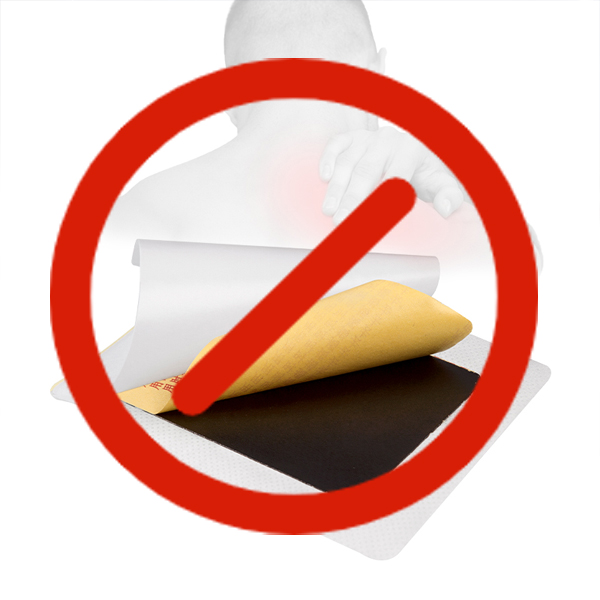Contraindications Of Herbal Pain Plaster
01. Correct use of herbal pain plaster
First, in the red, swollen and painful parts, disinfect with 75% alcohol, or wipe with ginger slices; if there is a wound, use dilute potassium permanganate solution to wash away the pus and blood and try to dry, then spread the folded herbal pain plaster, put it on a small fire to bake soft, sometimes due to the needs of the condition, in the baked soft herbal pain plaster evenly sprinkled with some powder, then repeatedly folded, spread the plaster, so that the healing effect is faster and better. This allows the powder to be mixed into the plaster so that it can be used more quickly and effectively.
In case of itching, massage the outside of the herbal pain plaster, if it does not work, remove it and rub the itchy area with an alcohol cotton ball and apply it again with warmth. If pus is present in the affected area, add some gauze to the surface of the herbal pain plaster, or cut a small hole in the ointment quilt paper so that the hole corresponds to the wound and is applied in order to drain the pus. For those who have erosion, pain, or blisters, the plaster can be applied to the wound, or the plaster can be removed, disinfected with alcohol, then applied with red salve and wrapped with gauze.
To apply herbal pain plaster, the affected area should first be wiped clean with an alcohol cotton ball and the film on the plaster should be torn off for application. The plaster should not be applied if there is skin erosion or trauma combined with infection.
02. contraindications to the use of herbal pain plaster
1. Do not apply herbal pain plaster or musk pain plaster to the injured area immediately when muscle contusions or joint or ligament strains are caused accidentally during normal exercise or labour. Because these creams have the effect of activating blood circulation and dispersing blood stasis, they cannot be applied immediately after the injury to reduce swelling and relieve pain.
2. Do not apply the ointment directly on the damaged area to avoid septic infection.
3. Any plaster containing musk, frankincense, saffron, myrrh, peach kernel and other ingredients that activate blood circulation and resolve blood stasis should be prohibited for pregnant women.
4. If local papules and blisters appear on the skin after applying herbal pain plaster, and if you feel intense itching, you are allergic to the plaster and should stop applying it immediately and undergo anti-allergy treatment.
5. If you feel itching, burning and tingling on the skin of the plastered area after applying the plaster for about 10 minutes, you should remove it as soon as possible. This indicates that the patient is allergic to the plaster. People with allergies should not usually apply the plaster because their skin is prone to rashes and applying it is not only detrimental to the absorption of the medicine, but can bring about skin problems.
6. No more than 24 hours As plasters are used on the muscular surface, plasters are generally taken with thick smelling drugs and applied to the body surface to stimulate the nerve endings, through reflexes, dilate blood vessels, promote local blood circulation, improve nutrition of surrounding tissues and achieve the purpose of reducing swelling, anti-inflammation and analgesia. Generally a dose of ointment should not exceed 24 hours at the longest, after a long time, not only has the drug lost its effectiveness, but also bad for the skin.
03. Four conditions that do not apply to herbal pain plaster
1. Allergies Some people are allergic to the herbal pain plasters and experience a burning sensation, itching, rash and even redness. Once the above adverse reactions are detected, the plasters should be discontinued and if the symptoms do not subside, a doctor should be consulted. In severe cases, apply an anti-inflammatory topical ointment such as dexamethasone to the allergic area and take anti-allergy medication under medical supervision if necessary.
2. Skin breaks should not be used if bleeding, localised redness, swelling and pain, or sores and pus are seen at the site of the skin break. Direct application of the ointment to the broken area may cause local over-absorption of the drug and cause adverse reactions.
3. Prolonged soaking in water Avoid bathing or prolonged soaking of the medicated area in water during the time of application, as this may result in loss of medication due to immersion and may cause the plaster to lose its viscosity and fall off.
4.Gout is often mistaken for trauma or rheumatism and some people use plasters on their own, which can delay the condition. It is advisable to consult a doctor before using the medication and to stop using the medication if you have serious discomfort afterwards and to seek medical advice promptly.







